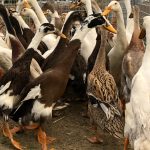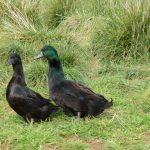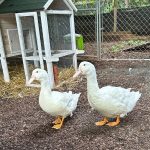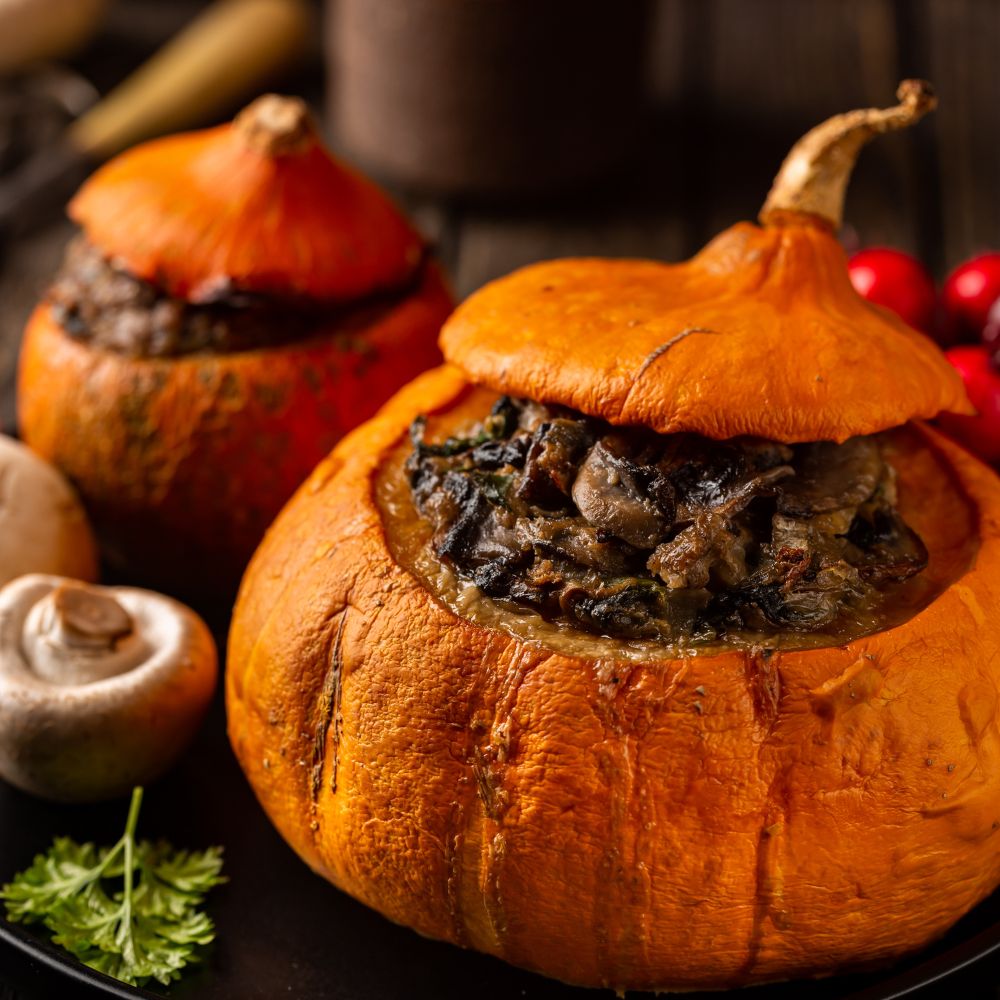by John Metzer, Metzer Farms Preserving Diversity Through Conservation Cayuga ducks (Courtesy Metzer Farms) When we think of America's agricultural past, images of cows, chicken, and fields of grain often come to mind. Yet quietly paddling through our rural and cultural history was another essential contributor – ducks. Ducks not only helped shape ... Read more The post Celebrate 250: Heritage Ducks in American History appeared first on The Livestock Conservancy.
by John Metzer, Metzer Farms
Preserving Diversity Through Conservation
When we think of America’s agricultural past, images of cows, chicken, and fields of grain often come to mind. Yet quietly paddling through our rural and cultural history was another essential contributor – ducks. Ducks not only helped shape early American farming but also continue to be used both commercially and in backyards to provide eggs, meat, feathers and pest control. Understanding their history is key to preserving their future.
From Asia and Europe to North America
The domesticated ducks’ journey to North America began long before the Mayflower. Domestication of most varieties of ducks started in Southeast Asia over 4,000 years ago with the wild Mallard. The only ducks that are not related to Mallards are Muscovy ducks. Muscovy ducks, a distinct species, originated and were domesticated in South and Central America by Indigenous peoples who introduced them to the southern regions of North America long before any European explorers arrived. But those varieties that originated as Mallards were brought to North America by European settlers, who valued ducks as a source of meat, eggs, and feathers and for their ability to forage, making them ideal for homesteads with access to ponds or creeks.
Early settlers favored ducks that were hardy, multipurpose, and adaptable to the new environment. Varieties like the Aylesbury, Dutch Hookbill, Runner and Muscovy were already being bred in Europe in the early 1800s and likely were the first varieties introduced into the wetland-rich landscapes of this continent.
Early Imported Ducks in American Life
In colonial America, ducks were far more than quaint barnyard fixtures. They were practical animals – efficient converters of insects, slugs, snails, grains and plants into rich meat and nutrient-dense eggs. On small farms, ducks were often raised alongside chickens. They were especially valued over chickens for their stronger disease resistance, ability to get nutrients from wet, marshy areas, excellent rendered fat and quality feathers and down.
In coastal and inland wetlands, ducks also helped control mosquito populations and provided a natural method of pest control in vegetable gardens, rice fields and orchards, long before synthetic pesticides existed. Runner ducks, which developed their tall, slender stance for pest control in Southeast Asia, also came via England. Once arriving here, they were maintained by small farmers but were never used for large-scale pest control in commercial rice farms.
Over time, these varieties lost favor to later introduced varieties. The Pekin, for example, was brought directly from China in 1873 to New York. Because of the Pekin’s meat attributes, the Long Island duck industry quickly developed, and the Pekin became the preeminent breed used for meat production, replacing several varieties previously used for this purpose.
American-Born Ducks
The only duck variety that was exclusively developed in the United States prior to 1900 was the Cayuga. It was developed in New York’s Finger Lakes region in the 1800s and is known for its iridescent green-black plumage. Hardy, quiet, and excellent foragers, Cayuga soon became a favorite in the northeastern U.S. for both meat and egg production. Two other domestic varieties of ducks were developed in the United States after 1900, the Australian Spotted and the Ancona. Although the name Australian Spotted suggests Australian origin, it was created in the United States by crossing several varieties, including an unidentified variety from Australia. Initially, the origin of the Ancona duck was disputed, questioning whether it was developed in Britain or the US. Once documents were found mentioning the Ancona in America before they were mentioned in England, it was concluded they were of American origin.
Pressures of Progress
The rise of large-scale agriculture in the early 20th century changed everything. As food systems grew to favor uniformity and efficiency, small-scale, multi-purpose ducks gave way to varieties bred specifically for meat production, especially the Pekin. Heritage ducks that grew slower, laid fewer eggs, or did not fit the standardized mold fell out of favor with commercial growers.
As a result, many heritage ducks saw a steep decline in population. The Australian Spotted, Dutch Hookbill and Aylesbury are now
ranked as Critical, and the Saxony and Magpie are considered Threatened by The Livestock Conservancy. The Buff, Cayuga, Welsh Harlequin, Blue Swedish, Black Swedish, Silver Appleyard, Ancona, Campbell and Rouen are included in the next category, Watch. In some cases, only a few dedicated breeders keep these lines from disappearing entirely.
Heritage Ducks Today
Heritage duck varieties embody regional histories and food traditions tied to the cultures of those who have cared for them for generations. In recent years, the local food movement and an emphasis on sustainable agriculture along with dedicated conservation efforts by farmers who recognize the unique traits of heritage ducks, have helped sustain their numbers. These ducks are an invaluable genetic resource that can continue to thrive only through the ongoing efforts of people who appreciate them today.
Organizations like The Livestock Conservancy, along with individual farmers and a growing number of hatcheries, are working to increase awareness and populations, improve breeding programs, and connect consumers with these birds. Maintaining heritage duck varieties is not just about saving old bloodlines; it’s about restoring balance and resilience to modern agriculture. As small farms reclaim sustainable, holistic food production methods, heritage ducks are uniquely positioned to help in several ways:
- Providing natural pest control in gardens and orchards
- Contributing to regenerative agriculture through foraging and manure
- Reducing reliance on chemicals and machinery
- Supplying local food systems with flavorful, high-quality meat and eggs
 Preserving heritage duck varieties means preserving the diversity, history, and sustainability of our agricultural heritage. Everyone values choice. Preserving these animals allows people a choice in size, color, foraging ability, meat qualities, egg production, brooding capabilities and temperament.
Preserving heritage duck varieties means preserving the diversity, history, and sustainability of our agricultural heritage. Everyone values choice. Preserving these animals allows people a choice in size, color, foraging ability, meat qualities, egg production, brooding capabilities and temperament.
Get Involved
Whether you are a homesteader, chef, educator, or backyard enthusiast, you can be part of the conservation movement.
- Choose heritage ducks when buying ducklings.
- Support farms that raise endangered ducks.
- Spread awareness through schools, blogs, or local events.
- Encourage local restaurants to try heritage duck meat and egg dishes.
- Partner with conservation groups or donate to their programs.
As a consumer, even if you never own ducks, you can support heritage duck varieties by seeking out and purchasing heritage duck products and spreading awareness of these amazing animals. Our online Breeders and Products Directory can help consumers find farms, markets, and distributors of ducks and duck products.
https://livestockconservancy.org/heritage-breeds/breeders-directory/
To learn more about heritage duck varieties on The Livestock Conservancy’s Conservation Priority List, check out the info at https://livestockconservancy.org/heritage-breeds/conservation-priority-list/
If you would like to support the ongoing work of The Livestock Conservancy, you can learn about becoming a member or donating at https://livestockconservancy.org/
Join Us Next Month
We’ll share a new blog each month in the Celebrate 250 ongoing series. You can find past blogs in the series at this link: https://livestockconservancy.org/250
In September, we will explore the history of the heritage donkey breeds on The Livestock Conservancy’s Conservation Priority List.
The post Celebrate 250: Heritage Ducks in American History appeared first on The Livestock Conservancy.














